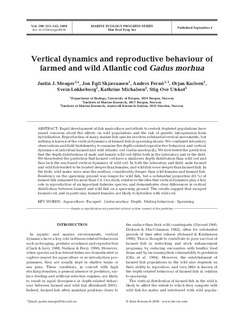Vertical dynamics and reproductive behaviour of farmed and wild Atlantic cod Gadus morhua
Meager, Justin J.; Skjæraasen, Jon Egil; Fernö, Anders; Karlsen, Ørjan; Løkkeborg, Svein; Michalsen, Kathrine; Utskot, Stig Ove
Journal article, Peer reviewed
Date
2009-09-04Metadata
Show full item recordCollections
- Articles [3011]
Original version
http://dx.doi.org/10.3354/meps08156Abstract
Rapid development of fish mariculture and efforts to restock depleted populations have raised concerns about the effects on wild populations and the risk of genetic introgression from hybridisation. Reproduction of many marine fish species involves substantial vertical movements, but nothing is known of the vertical dynamics of farmed fish in spawning shoals. We combined laboratory observations and field biotelemetry to examine the depth-related reproductive behaviour and vertical dynamics of individual farmed and wild Atlantic cod Gadus morhua (L). We first tested the prediction that the depth distributions of male and female wild cod differ both in the laboratory and in the field. We then tested the prediction that farmed cod have a shallower depth distribution than wild cod and thus lack the sex-based vertical dynamics of wild cod. In both the laboratory and field, male farmed and wild fish tended to be located deeper than females, and wild fish were deeper than farmed fish. In the field, wild males were near the seafloor, considerably deeper than wild females and farmed fish. Residency on the spawning ground was longer for wild fish, but a substantial proportion (61%) of farmed fish remained for more than 3 d. Our study reinforces the idea that vertical dynamics play a key role in reproduction of an important fisheries species, and demonstrates clear differences in vertical distribution between farmed and wild fish on a spawning ground. The results suggest that escaped farmed cod, and in particular, farmed females, are likely to hybridise with wild cod.
